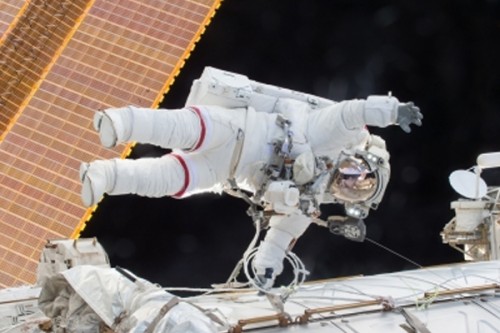New therapy offers hope for preventing bone loss in space

San Francisco, Sep 20 (IANS) Researchers have developed a therapy that showed promise to mitigate extreme bone loss from long-duration space travel as well as musculoskeletal degeneration on Earth.
Microgravity induces bone loss at a rate 12-times greater than on Earth. Astronauts in low Earth orbit may experience bone loss up to one per cent every month, endangering their skeletal health and increasing the risk of fractures during long-duration spaceflight and later in life.
Researchers at the University of California at Los Angeles (UCLA) investigated whether systemic delivery of NELL-like molecule-1 (NELL-1) can reduce microgravity-induced bone loss.
NELL-1 is a protein that is crucial for bone development and bone density maintenance.
The team enhanced NELL-1's therapeutic potential by extending the molecule’s half-life from 5.5 hours to 15.5 hours without losing bioactivity and bioconjugated an inert bisphosphonate (BP) to create a “smart” BP-NELL-PEG molecule that more specifically targets bone tissues without the common destructive effects of BP.
The findings, published in journal ‘npj Microgravity’, showed that BP-NELL-PEG displayed superior specificity for bone tissue without causing observable adverse effects.
“Our findings hold tremendous promise for the future of space exploration, particularly for missions involving extended stays in microgravity,” said Chia Soo from UCLA.
“If human studies bear this out, BP-NELL-PEG could be a promising tool to combat bone loss and musculoskeletal deterioration, especially when conventional resistance training is not feasible due to injuries or other incapacitating factors,” said co-co-principal investigator, Kang Ting from the Forsyth Institute in Cambridge, Massachusetts.
To test BP-NELL-PEG in real space conditions, the researchers conducted a mice study, where they exposed half of the ISS mice to microgravity for a lengthy nine-week period to simulate the challenges of long-duration space travel.
The remaining mice were flown back to Earth at 4.5 weeks post-launch. Both groups were treated with either BP-NELL-PEG or phosphate buffered saline (PBS) control.
An equivalent cohort of mice remained at the Kennedy Space Centre and was treated with BP-NELL-PEG or PBS, to serve as normal Earth gravity controls. Both flight and ground mice treated with BP-NELL-PEG exhibited a significant increase in bone formation.
The treated mice in space and on Earth displayed no apparent adverse health effects. “This bioengineering strategy can also have important benefits on Earth, offering a potential therapy for patients suffering from extreme osteoporosis and other bone-related conditions,” said Ben Wu from Forsyth.

|

|

